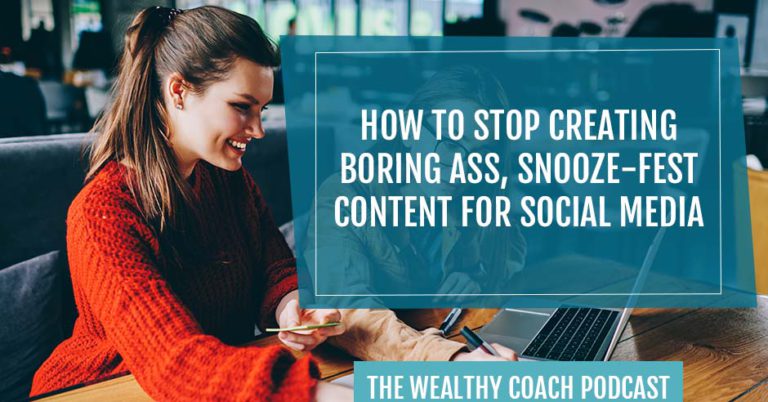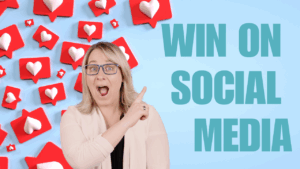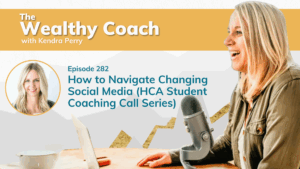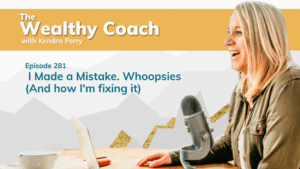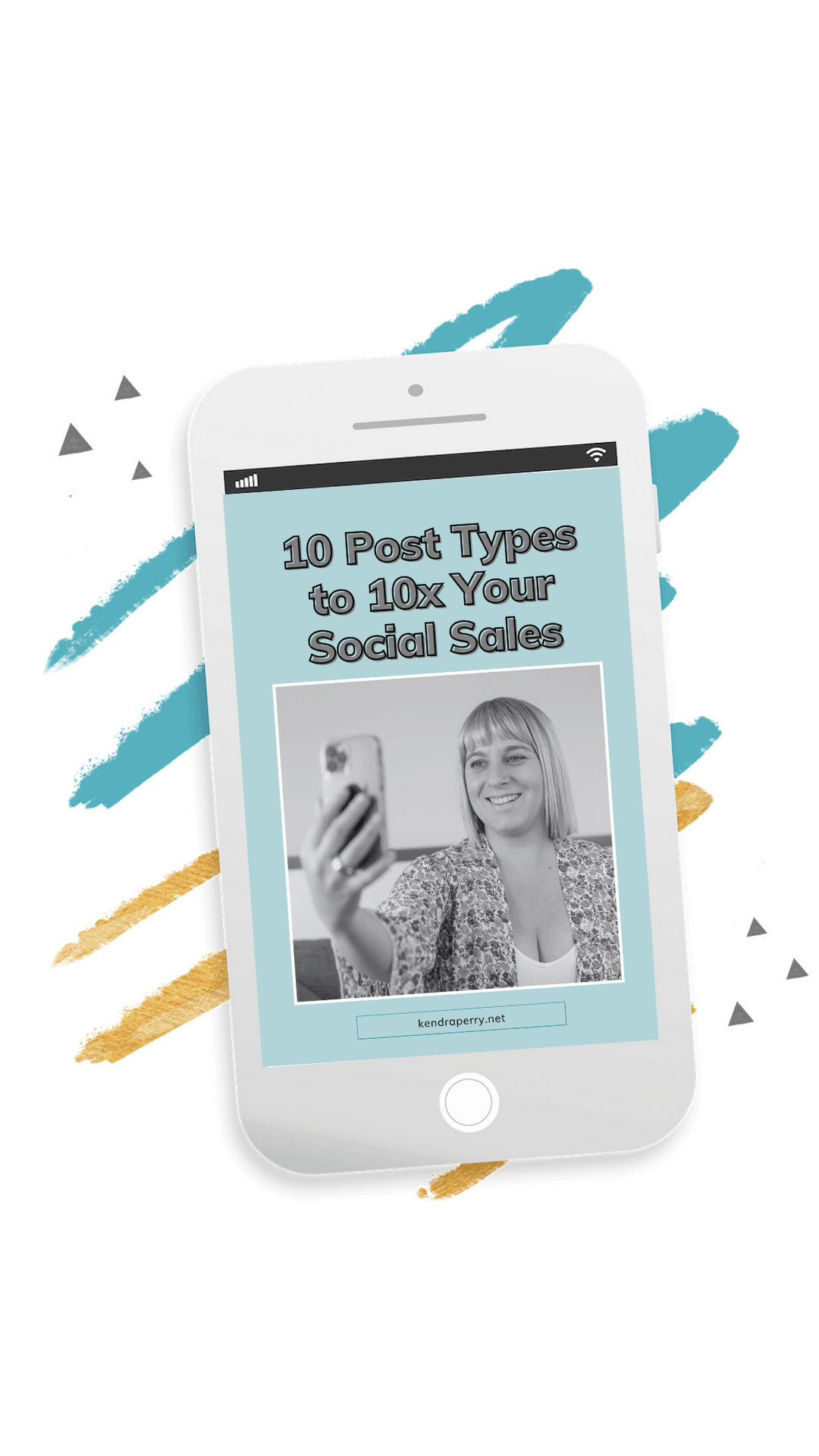Creating compelling social media content does not just mean filling your blog with so many words. If you’re not getting your desired results and your content isn’t making the right impact on your audience, it’s time to get serious about what you’re putting out there. And in this age of information, your content has got to be more than just giving away data. In this episode, Kendra Perry shares gold nuggets on engaging materials for your social media followers and discusses the importance of creating content in the first place! Tune in now and learn how to stop making your social media accounts a mere collection of boring ass, snooze-fest content!
—
Listen to the podcast here
How To Stop Creating Boring Ass, Snooze-Fest Content For Social Media
How to Stop Creating Boring Ass, Snooze-Attack Content
When I started as a health practitioner, I was told to create valuable content and give away my best stuff for free. That’s exactly what I did. I created content after content and social media posts. At the time, it was Facebook because leave it or not, when I started my business, Instagram didn’t even exist. It’s crazy. I’m dating myself. I got engagements. People would say, “Kendra, you’re so inspiring. This is a great piece of content.”
It wasn’t helping me get clients and that was frustrating, to say the least. Maybe you’ve been given this information. The most common piece of information that we’re given around social media content is to post valuable content consistently. What leads us to believe is that’s the only thing that we need to do to grow a social media following and get clients from social media.
What we end up doing is posting a lot of educational content like, “Here’s how to do this, here’s how to learn about the adrenal glands, this is what adrenal fatigue is, this is how you do this and that, this is how you stay hydrated, this is how you eat healthily,” and all those sorts of things. I will not include myself in this but you probably think that all you need to do is show people how smart you are and give away your best information for free. People will be like, “They’re so smart. They know so much.” They’re going to want to work with you. You’re like, “I’m going to get so many clients.”
That’s wrong. That is not how it works. I am so sorry to be the bearer of bad news. Educational content, in my opinion, what I’ve seen is the wrong way to create content online. When you only share educational content, what happens is you get known as the Free Tips Girl or Free Tips dude. People flock to your account to get the free stuff, meaning that you’re up there swinging around your pole, giving it all away for free and your audience is just there for the free show.
They might come back over and over again but as always, they are only there for the free show. That doesn’t feel good, does it? That’s because an effective content marketing strategy is not just showing your audience everything that you know. One of the biggest things that I’ve learned in the business is information does not equal transformation. If information led to transformation, everyone would be transforming all over the place and then we’d all be out of business.
We live in the age of information. We have the most powerful search engine in all of human history called Google and people can find anything that they want. What they’re needing from you is not more information because when you fill them up with information, they’re either overwhelmed, they don’t take action or they feel like they have everything they need. Imagine you owned a restaurant and you were like, “I want to get people in the door so I’m going to give away free samples.”
You’re hoping that they’ll come in and buy the main course but after so many free samples, customers are full. Their bellies distended. They’re bloated. They’re like, “I ate so much. There’s no room for the main course.” We do not want to do that with your content. There is only one reason you are showing up on social media. You’re not showing up to give away information, be another version of Google or give away free tips and impress people. The purpose of your content is to get people to buy. That’s it.
In HCA, I recommend that my students only share about 15% of their content as traditional free tips and educational content. There is a place for that but I would go so far as to say that the majority of health coaches and practitioners who are trying to build online businesses are sharing 100% of their content as health tips and what we call educational content. 15% is acting like 85% of your content. What’s that 85% for? What is it about? The rest of your content, that 85%, is to get them ready and prepare them to enroll in your program. What does that mean?
Get People To Connect With You
To get people ready to buy, we have to do three different things. Number one, we have to get them to connect with us. They need to feel connected to us in some way. They resonate with us, they see their selves in us, they want to be us or something like that. Number two, we need to develop a relationship with them. We need to nurture them and help them get to know us. Finally, we have to get them to take the next step and enroll in our program.
Let’s break that down. Number one, help them connect with us. How do we do that? An easy way to do that is by sharing your story. There’s a good chance that you have had the same struggle that your current audience is struggling with and needs help with. For example, I used to be a struggling health practitioner.
I started my business in 2015 as a functional health practitioner. I had no idea how to do online business. I didn’t have a business plan or any relevant education or experience. I just showed up online so I had a lot of struggles. I could share that story and I do share that story. I share that story all the time. There’s a reason for that because it connects with you. You see yourself in my story when I tell you.
I felt so much shame when people were like, “How’s your business going?” I would lie through my teeth and be like, “It’s great.” Meanwhile, on the inside, I felt embarrassed and shame because I wasn’t making money, I didn’t have clients and I felt like a failure. I shared a little bit of a story there. Did you see yourself in it? You probably did. You’ve probably felt that way. Your story might be a little bit different than mine but I bet you resonated with the emotions I described, the feeling of shame, embarrassment and being a failure. You’ve felt that.
We call this the origin story. It’s the story of where you were and how you got to where you are as a practitioner or coach. That can help people connect with us. We can also share other relevant stories. You’ll notice that in my episodes and content, I’m often sharing a story. I’m creating an analogy out of it or I’m sharing a lesson from the story so we can share other relevant stories that convey a lesson. You don’t need to have any intense stories like interesting stories. You don’t need that. You can have a very boring life like me and still have stories to share. What we’re doing is looking for stories that can convey a lesson. That’s it.
There are all kinds of stories that can convey a lesson, even seemingly boring ones. We focus on describing the emotion that we were feeling in the story, whether that’s sadness, shame, happiness, joy or whatever it is and on the small details. I am sitting at my desk looking out the window and the snow is coming down. The whiteness of it is blinding me a little bit. Do you see what I’m saying? I like sharing those little details and that can make a story more interesting as well.
Stories are powerful because they’re written into our DNA. Stories are the old internet in a lot of ways. It’s how information was passed along. It’s how knowledge and wisdom were passed down through the generations. Many of our ancestors sat around the fire with their elders and listened to stories. Humans love stories. Another way you can help them connect with you is to teach them about your philosophy around their problem or your industry or niche.

You have a philosophy that’s different from other people. There are certain things that you believe about the space that you work in and your clients and the problem that they have that are different from others. That’s how you can differentiate yourself. You should always share content that describes your philosophy. That’s how we can start by getting people to connect with us.
Develop A Relationship With Your Audience
The next thing we want to do is remember to create a relationship with them. Three different types of content help people build a relationship with you. The first one is what I call connection content. Connection content doesn’t necessarily have to be niche specific, meaning that it could be outside your niche but the keyword, the thing that you don’t want to omit is relevancy. It has to be relevant.
How can something have nothing to do with the problem that they have and still be relevant while it connects with a common shared value? If you want to be able to connect with values, you need to know your values and understand the values of your audience. I’ll use myself as an example. I used to be a health practitioner so I value health. Health is incredibly important to me. I serve health coaches. There you go. There is a common mutually shared value. I know you value health and wellness and personal development and I do the same thing.

Sometimes I share content that’s about health. It might be about my health journey. I like to do a little personal health life update on the show every now and then. Sometimes I’ll share my struggle with chronic fatigue and how I got through that. It has nothing to do with business or marketing but it connects with a shared mutual value. That will help you build a relationship with me because it makes you feel like we have something in common. This connection content is in the build-a-relationship phase but a lot of the stuff overlaps. People aren’t going to work with you inside a transformational-based program if that connection isn’t there.
People don’t need to necessarily connect with you to buy a $27 or $50 product but if you want them to come into your program and spend $1,000, $2,000 or $3,000 to work with you intimately, then they’re going to need to feel connected with you and like you in some way. This connection piece is important. When all you’re doing is sharing how smart you are, how to stay hydrated, how to eat paleo or how to make gluten-free muffins, there’s no connection in that. There’s no story. While people might be like, “That was a great recipe,” they have no sense of who you are or why they should care.

The second thing you want to do is shift limiting beliefs. I guarantee that your audience has certain beliefs that are incorrect or they’re wrong or those beliefs are keeping them stuck. If people believe certain things, they will never sign up for your program. For example, if you believe that the only way for you to be a successful business owner is to have a website and you think you need to build a website before you do anything else, you’re probably not going to invest in Health Coach Accelerator.
1) I don’t teach websites in Health Coach Accelerator. They’re crap. 2) A website can take a long time to build. I’ve built a bunch of them and it took me years. That is a limiting belief. You’re like, “I need this website so I can feel professional and then I can do this.” I have to shift that first or you’re never going to be ready to invest in my program. Another example is let’s say you’re in a weight loss niche. Maybe you help women in their 50s lose 20 pounds or something like that but there are people in your audience who believe that they need the willpower to lose weight. They’re like, “I don’t have willpower.”
Maybe inside your program, you teach them that they don’t need willpower. They just need to do micro habits or something else. They need to create these little micro habits and stack them on top of each other and that’s what’s going to help them commit to the program. That would be a limiting belief. “I don’t have willpower so I can’t lose weight.” If they believe that they don’t have willpower and they need it to lose weight, they’re never going to sign up for your weight loss program. That would be a limiting belief that you would need to shift.
There are all kinds of beliefs that people have about their health and their ability to heal. You need to utilize your content to shift those. If they continue to internalize those limiting beliefs, then they will never become a client. This helps them build a relationship with you because you’re shifting the way they think. You’re freeing them from the chains of limiting beliefs that are preventing them from moving forward, that are keeping them stuck in the place that they don’t want to be in.
The third way you can create a relationship with them is by educating them. Here is the educational content. 1) We have to get them to connect with us. I give you three different types of content to share to do that. 2) They need to create a relationship with us. I’ve given you three different types of content to share. This is only one piece of it. If all you’re doing is sharing educational content then they’re not going to buy from you. It’s one small piece of the strategy.
Help People Take The Next Step
When I say educational content, this is like the how-to content, how to heal your adrenal burnout, how to get off coffee, how to exercise and lose weight without cardio and all of these things. There is a place for that but if that’s all you’re doing, it’s not going to get you what you want, which is to get clients and help change lives. 3) We need to help them take the next step. There are a few different types of content that you can share here.
The first one I want to talk about is future pacing, which is helping them get into the mindset of where they could be. If they’re going to work with you, they need to believe that they can get there. They need to have a vision of the future in which they don’t have the problem they have anymore. They need to believe that’s possible. Future pacing is speaking to their desires and where they could be if they fix their problem and work with you.

The second type of content that helps them take the next step in is addressing objections. We’re all aware of sales objections. If you’ve ever done sales calls or chatted with people in DMs, there are a few objections that come up regularly. “It was too expensive. I don’t have the time. I’m not sure if this is the right fit. I need to ask my spouse.” These are objections that come up all the time. We tend to react to them in a very reactive way so we address them as they come up. What if we were preventative with objections?
If we know we’re always going to get a few objections, then we need to address them in our content. This preemptively addresses the objection before it even comes up. We need to utilize our content to show them why this program that you’re selling is a great investment. For example, if you’re working with clients who have type 2 diabetes, you could show them in numbers how it’s way cheaper to enroll in your program and solve their diabetes versus all the money that they would spend on health insurance, prescriptions, surgeries and all the things.
Diabetes is a chronic condition and all these things can go wrong. It can cost a person so much money, which is way more expensive than spending $3,000 on your program and reversing type 2 diabetes. The more concrete you can get with numbers, the better. This might not be possible for every type of niche but there are certain niches where it’s like, “You’re going to be spending a lot of money to maintain this condition. Why don’t we just get rid of it?”
You also want to be talking about your offer. A lot of coaches and practitioners are afraid to talk about their offers. They may be seated every now and then but we need to be talking about it all the time. You want to be the biggest cheerleader/ambassador for your program. You want to be like, “This is the best program and you were stupid to not enroll in it.” That’s how I feel about Health Coach Accelerator.
It’s so ridiculous and stupid that you wouldn’t enroll. I do believe that because I watched so many coaches out there trying to figure this all out on their own and then they’re like, “I don’t know.” Six months later, they didn’t do the program. They’re like, “I need to do this first.” Six months later, I follow up with them and they’re in the same place. They haven’t made any steps forward and they’re having the same experience. That thing drives me insane. It doesn’t make sense for them not to do HCA. I believe that about you and everyone reading.
You’ve got to be talking about your offer so that people know that you have something to sell. If people don’t know you have something to sell, they’re never going to buy. Finally, you need to create urgency and scarcity and get them to enroll. Urgency is when there’s a deadline. I’m closing the doors and carts on Friday at midnight. Scarcity is limited spots.
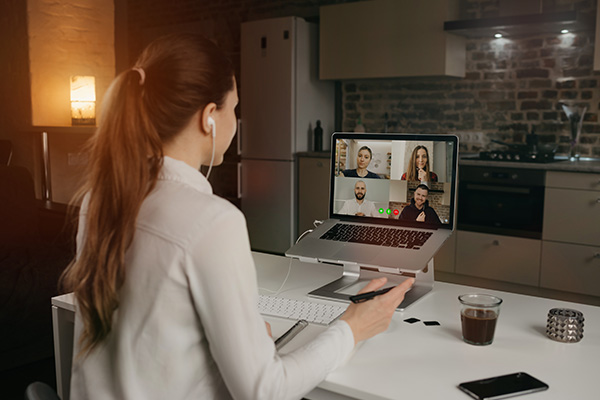
You can utilize scarcity. It depends on what type of program you’re selling and how you’re selling it. For example, if you’re doing a group coaching program, then you will be able to utilize urgency, especially if you have an open-close card. Maybe you run your program live and it opens and closes on specific dates. It’s cohort style. Everyone starts on the same date and everyone ends on the same date. That’s great. You can use urgency or perhaps you have a promotion going on where they can get $500 off for 5 days. That’s urgency.
Scarcity means there are limited spots. I find these work better when you are doing a one-on-one program. You can only take so many one-on-one clients at once. Maybe you can only take three clients a month. “I have 3 or 2 spots left.” Sign a client. You can use urgency and scarcity to get them to enroll. Let’s summarize this because I know I went through a lot.
We have three bigger topics. The purpose of the content is, 1) To help them connect with us, 2) To create a relationship with them and, 3) To help them take the next step and enroll in our program. Those are the three topics. Underneath helping them connect with us, we can share our origin story, the story of how we got from problem to solution. We can share other relevant stories that convey a lesson or an analogy that is relevant to your audience. We can teach them a better philosophy and why it’s different.
That all goes under helping them connect with us. We then want to get them to create a relationship with us. That’s where we bring in connection content, which speaks to shared and common values. We shift limiting beliefs to blow their minds and help them get unstuck from beliefs that are keeping them in the same place that they don’t want to be in and then we educate them. This is where that how-to content comes in.

We need to help them take the next step. We do that by future pacing and showing them what’s possible and addressing objections. Things like, “It’s too much money. I don’t have the time. I need to talk to my spouse.” We talk about our offer like we are the cheerleader for the team of our offer and then we create urgency and scarcity to get them to enroll.
I hope this has helped clarify content. The biggest mistake that you can be making with your content is sharing educational content that is not going to serve you or your business. That does your clients a disservice because it keeps them stuck. A little bit is okay but 15% max. I hope you love this episode. It was super fun as always hanging out with you. I will see you in the next episode, same time and same place where I help you become wealthy AF.
Important Links

